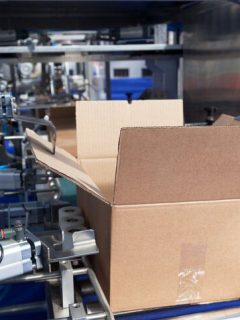Innovations in supply chain management play a key role in operational efficiency and customer satisfaction. One of the most promising trends in this area is RFID (Radio-Frequency Identification) and NFC (Near Field Communication) technologies, which are revolutionising the ways in which packaging is tracked, identified and managed. What opportunities do they offer and when should they be used?
RFID and NFC – characteristics
RFID (Radio-Frequency Identification) and NFC (Near Field Communication) technologies are extremely practical tools for identifying and tracking products throughout the supply chain. What exactly characterises them?
RFID (Radio Frequency Identification)
RFID enables contactless identification and remote reading of data from tags that are placed on products or packaging. This technology works over longer distances, allowing products to be tracked quickly and automatically even in industrial settings. RFID tags can store a variety of information, such as product data, serial number, expiry date, or history of location and transport conditions.
They are used in a variety of industries: logistics, retail, manufacturing or even healthcare to facilitate inventory management and increase the efficiency of logistics processes.
NFC (Near Field Communication)
NFC, like RFID, enables wireless communication, but operates on a short-range basis and requires direct contact with an NFC reader. This type of technology is commonly used in mobile devices such as smartphones, among others, allowing a variety of applications for contactless payment, data transfer and access control.
In the context of packaging, short-range communication can be used to allow customers to access additional product information. All they need to do is touch the packaging with their smartphone. Another use of NFC is to secure products by placing tags with unique identifiers that can only be read by authorised devices.
Application of RFID and NFC
RFID and NFC technologies significantly improve logistics processes. For what purposes are they used?
Inventory tracking and monitoring
The use of RFID and NFC in packaging allows the continuous tracking of product locations throughout the supply chain. This allows companies to accurately monitor stock levels, avoiding problems associated with missing products on the shelves or overstocking.
2 Optimising logistics processes
Remote tracking of packaging and products, allows companies to optimise the delivery route and thus avoid unnecessary delays and costs associated with transport.
What’s more, the automated data collected via RFID and NFC can be integrated into warehouse management and ERP (Enterprise Resource Planning) systems, allowing for more efficient resource and demand planning.
3 Appropriate product storage conditions
Monitoring temperature and humidity using RFID and NFC technology is a key element in ensuring appropriate product storage conditions, especially when it comes to food and pharmaceutical goods.
In addition, these technologies allow a history of storage conditions to be tracked so that potential problems in the supply chain can be identified and resolved.
Read also: eco-friendly stretch film – winner of packaging innovation award.
4 Ensuring authenticity and security
RFID and NFC also help to ensure product authenticity and security. How? By placing RFID or NFC tags on packaging, companies can trace the product from the manufacturer to the end customer. This makes it possible to detect and prevent product counterfeiting and theft.
5 Personalisation and customer interaction
Finally, the use of RFID and NFC in packaging opens up new opportunities for product personalisation and customer interaction. Because RFID and NFC tags store additional product information, companies can offer customers a more personalised shopping experience, for example by providing additional product information, promotional offers or loyalty bonuses.
Summary
The packaging industry is constantly evolving, not least through the use of modern solutions. Innovative packaging, advanced technologies, eco-friendly materials – all of these are changing the functioning of logistics processes. RFID and NFC technologies also have great potential to revolutionise supply chain management.
Their use in packaging allows companies to continuously track and monitor products, optimise logistics processes, ensure the authenticity and security of goods, and personalise the shopping experience of customers. As these technologies continue to evolve, their role in supply chain management can be expected to grow, opening up new opportunities for logistics companies and many other industries.














